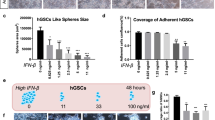Summary
As CD40 transduces activation signals involved in inflammatory and immune disorders, we explored the expression and response to CD40 engagement in human glioma cell lines in this study. The CD40 expression in BT-325 and U251 cells was flow cytometrically detected. The cells were incubated with srhCD40L for 72 h to assess its effects on cell growth in vitro. TNF-α expression was quantified by real-time PCR, and protein expression was analyzed by ELISA. The I-κb mRNA was detected by RT-PCR. I-κB expression decreased after stimulation with 1 μg/mL srhCD40L, but it was upregulated after the cells were pretreated with CD40 antibody. srhCD40L significantly inhibited the proliferation of the CD40+ human glioma cells. The stimulation of CD40+ glioma cells with soluble CD40L (CD154) up-regulated the expression of TNF-α at both mRNA and protein levels. We are led to conclude that CD40L/CD40 could inhibit human glioma cells through I-κb signaling pathway. Interferon-γ can augment CD40 expression and the inhibitory effect of CD40 ligand on cell growth in vitro. These results suggest that srhCD40L may benefit the therapy strategy of glioma.
Similar content being viewed by others
References
Harnett MM. CD40: a growing cytoplasmic tale. Sci STKE, 2004,2004(237):pe25
Geldart T, Illidge T. Anti-CD40 monoclonal antibody. Leuk Lymphoma, 2005,46(8):1105–1113
Wischhusen J, Schneider D, Mittelbronn M, et al. Death receptor-mediated apoptosis in human malignant glioma cells: modulation by the CD40/CD40L system. J Neuroimmunol, 2005,162(1–2):28–42
Stamenkovic I, Clark EA, Seed B. A B-lymphocyte activation molecule related to the nerve growth factor receptor and induced by cytokines in carcinomas. EMBO J, 1989,8(5):1403–1410
Thomas WD, Smith MJ, Si Z, et al. Expression of the co-stimulatory molecule CD40 on melanoma cells. Int J Cancer, 1996,68(6):795–801
Chen K, Huang J, Gong W, et al. CD40/CD40L Dyad in the Inflammatory and Immune Responses in the Central Nervous System. Cell Mol Immunol, 2006,3(3):163–169
Airoldi I, Lualdi S, Bruno S, et al. Expression of costimulatory molecules in human neuroblastoma. Evidence that CD40+ neuroblastoma cells undergo apoptosis following interaction with CD40L. Brit J Cancer, 2003,88(10):1527–1536
Hirano A, Longo DL, Taub DD, et al. Inhibition of human breast carcinoma growth by a soluble recombinant human CD40 ligand. Blood, 1999,93(9):2999–3007
Hakkarainen T, Hemminki A, Pereboev AV, et al. CD40 is expressed on ovarian cancer cells and can be utilized for targeting adenoviruses. Clin Cancer Res, 2003,9(2):619–624
Hill SC, Youde SJ, Man S, et al. Activation of CD40 in cervical carcinoma cells facilitates CTL responses and augments chemotherapy-induced apoptosis. J Immunol, 2005,174(1):41–50
Ehtesham M, Kabos P, Gutierrez MA, et al. Intratumoral Dendritic Cell Vaccination Elicits Potent Tumoricidal Immunity Against alignant Glioma in Rats. J Immunother, 2003,26(2):107–116
Imbeault M, Ouellet M, Tremblay MJ. Efficient magnetic bead-based separation of HIV-1-infected cells using an improved reporter virus system reveals that p53 up-regulation occurs exclusively in the virus-expressing cell population. Virology, 2009,393(1):160–167
Pang Y, Cai Z, Rhodes PG. Analysis of genes differentially expressed in astrocytes stimulated with lipopolysaccharide using cDNA arrays. Brain Res, 2001, 914(1–2):15–22
Sui Z, Sniderhan LF, Schifitto G, et al. Functional synergy between CD40 ligand and HIV-1 Tat contributes to inflammation: implications in HIV type 1 dementia. J Immunol, 2007, 178(5):3226–3236
Sui Z, S. Fan L, Sniderhan, E, et al. Inhibition of mixed lineage kinase 3 prevents HIV-1 Tat-mediated neurotoxicity and monocyte activation. J Immunol, 2006,177(1):702–711
Benveniste EN, Nguyen VT, Wesemann DR. Molecular regulation of CD40 gene expression in macrophages and microglia. Brain Behav Immun. 2004,18(1):7–12
Niederberger E, Geisslinger G. The IKK-NF-kappaB pathway: a source for novel molecular drug targets in pain therapy? FASEB J, 2008,22(10):3432–3442
Author information
Authors and Affiliations
Corresponding author
Additional information
This work was supported by a grant from the Ministry of Education for New Teachers, China (No. 20070487132).
Rights and permissions
About this article
Cite this article
Zhang, Y., Huang, T., Hu, Y. et al. Activation of CD40 by soluble recombinant human CD40 ligand inhibits human glioma cells proliferation via nuclear factor-κB signaling pathway. J. Huazhong Univ. Sci. Technol. [Med. Sci.] 32, 691–696 (2012). https://doi.org/10.1007/s11596-012-1019-1
Received:
Published:
Issue Date:
DOI: https://doi.org/10.1007/s11596-012-1019-1




